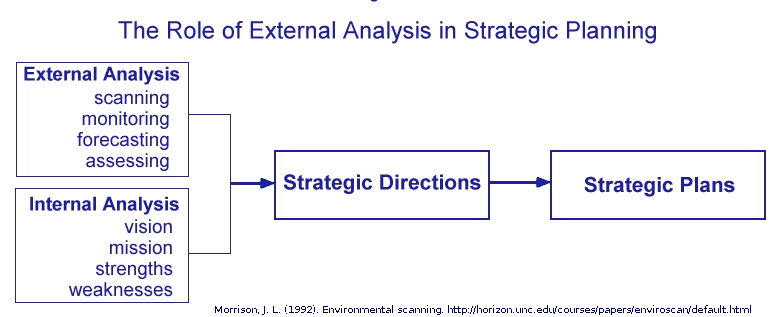Environmental scanning: Difference between revisions
m (Created page with '{{Stub}} Category: Innovation and change Category: Organization and management') |
m (using an external editor) |
||
| Line 1: | Line 1: | ||
{{Stub}} | {{Stub}} | ||
== Introduction == | |||
'''Environmental scanning''' can be considered part of good management and more precisely [[change management]], since organizations must learn. | |||
According to Morrison (1992), Brown and Weiner (1985) define environmental scanning as "a kind of radar to scan the world systematically and signal the new, the unexpected, the major and the minor" (p. ix). | |||
Scanning is conceptualized in various ways. | |||
== The Morrison model == | |||
{{quotation|Environmental scanning is one of four activities comprising external analysis. As illustrated in Figure 1, external analysis is the broader activity of understanding the changing external environment that may impact the organization. In describing external analysis, Fahey and Narayanan (1986) suggest that organizations scan the environment to identify changing trends and patterns, monitor specific trends and patterns, forecast the future direction of these changes and patterns, and assess their organizational impact. Merged with internal analysis of the organization's vision, mission, strengths, and weaknesses, external analysis assists decisionmakers in formulating strategic directions and strategic plans.}} (Morrison, 1992). | |||
[[image:environmental-scanning-morrison-1992.gif|frame|none|Morrison, J. L. (1992). Environmental scanning]] | |||
For higher education, Morrison (1992) suggests the following procedure: | |||
Firstly onw has to decide which level of scanning commitment is best for your institution at this time: irregular, periodic, or continuous. Irregular is least expensive, but also least effective. Continuous scanning requires hiring a professional who also has to work with peers that include faculty members from all disciplines plus administratives. These peers then need to be trained in a little half or full day workshop. | |||
Morrison (1992) then identifies a few trends that participants should look at: | |||
* Seek signs of change. | |||
* Look for signals of potential events on the horizon. | |||
* Look for forecasts of experts. | |||
* Look for indirect effects. | |||
* Examine the whole social, technological, economic, environmental, and political ('''STEEP''') macroenvironment | |||
He then provides some extra advice that participants must understand | |||
* Be aware that there are few guidelines on how to do scanning. | |||
* Write '''short''' abstracts. | |||
== Bibliography == | |||
Morrison, J. L. (1992). Environmental scanning. In M. A. Whitely, J. D. Porter, and R. H. Fenske (Eds.), A primer for new institutional researchers (pp. 86-99). Tallahassee, Florida: The Association for Institutional Research.[http://horizon.unc.edu/courses/papers/enviroscan/default.html HTML Reprint] | |||
[[Category: Innovation and change]] | [[Category: Innovation and change]] | ||
[[Category: Organization and management]] | [[Category: Organization and management]] | ||
Revision as of 16:38, 28 October 2009
Introduction
Environmental scanning can be considered part of good management and more precisely change management, since organizations must learn.
According to Morrison (1992), Brown and Weiner (1985) define environmental scanning as "a kind of radar to scan the world systematically and signal the new, the unexpected, the major and the minor" (p. ix).
Scanning is conceptualized in various ways.
The Morrison model
“Environmental scanning is one of four activities comprising external analysis. As illustrated in Figure 1, external analysis is the broader activity of understanding the changing external environment that may impact the organization. In describing external analysis, Fahey and Narayanan (1986) suggest that organizations scan the environment to identify changing trends and patterns, monitor specific trends and patterns, forecast the future direction of these changes and patterns, and assess their organizational impact. Merged with internal analysis of the organization's vision, mission, strengths, and weaknesses, external analysis assists decisionmakers in formulating strategic directions and strategic plans.” (Morrison, 1992).
For higher education, Morrison (1992) suggests the following procedure:
Firstly onw has to decide which level of scanning commitment is best for your institution at this time: irregular, periodic, or continuous. Irregular is least expensive, but also least effective. Continuous scanning requires hiring a professional who also has to work with peers that include faculty members from all disciplines plus administratives. These peers then need to be trained in a little half or full day workshop.
Morrison (1992) then identifies a few trends that participants should look at:
- Seek signs of change.
- Look for signals of potential events on the horizon.
- Look for forecasts of experts.
- Look for indirect effects.
- Examine the whole social, technological, economic, environmental, and political (STEEP) macroenvironment
He then provides some extra advice that participants must understand
- Be aware that there are few guidelines on how to do scanning.
- Write short abstracts.
Bibliography
Morrison, J. L. (1992). Environmental scanning. In M. A. Whitely, J. D. Porter, and R. H. Fenske (Eds.), A primer for new institutional researchers (pp. 86-99). Tallahassee, Florida: The Association for Institutional Research.HTML Reprint
